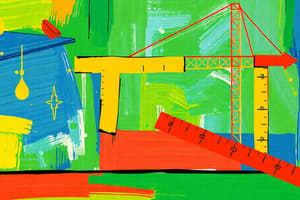Podcast
Questions and Answers
What is the first step in test construction?
What is the first step in test construction?
Identifying a need
What should a test be guided by?
What should a test be guided by?
Relevant theories
What is the purpose of a table of specifications in test construction?
What is the purpose of a table of specifications in test construction?
To organize subtopics, their importance, and number of items needed
The initial pool of items should be smaller than the actual number of items needed.
The initial pool of items should be smaller than the actual number of items needed.
What types of reliability should be established in a test?
What types of reliability should be established in a test?
The calculation of __________ involves the mean and standard deviation of groups.
The calculation of __________ involves the mean and standard deviation of groups.
Which item type involves the participant selecting a correct or best response?
Which item type involves the participant selecting a correct or best response?
Match the following item types with their descriptions:
Match the following item types with their descriptions:
What is a potential con of true-false items?
What is a potential con of true-false items?
__________ is the measurement of the performance via direct assessment.
__________ is the measurement of the performance via direct assessment.
What is the main purpose of conducting pilot testing?
What is the main purpose of conducting pilot testing?
Flashcards are hidden until you start studying
Study Notes
Overview of Test Construction
- Identify a specific need for a new test, focusing on areas lacking existing measurement tools.
- Theoretical frameworks guide test design, ensuring that components align with established measurement theories rather than personal beliefs.
Principles Underlying Test Construction
- Practical choices in test creation involve decisions about format, scoring methods, time limits, and presentation style.
- Develop a table of specifications that organizes subtopics, their importance, and the number of items per subtopic to ensure comprehensive coverage.
- Expand the initial item pool to 4-5 times the number required, aiming for a diverse selection based on various sources and expert input.
Item Refinement Process
- Initial items often need clarification and simplification, undergoing feedback from experts for improvement.
- Conduct pilot testing to identify problematic items and assess overall test functionality.
- Analyze item relevance through item analysis and sort content areas using content analysis.
Ensuring Reliability and Validity
- Reliability denotes consistency, assessed via test-retest, parallel, interrater, and internal consistency methods.
- Validity pertains to accuracy, examined through face, content, criterion, and construct validity.
- It is crucial to determine which forms of reliability and validity apply to a specific test.
Standardization and Norming
- Standardize administration and scoring to ensure comparability across different test administrations.
- Norms are derived from the average and standard deviation of scores from representative groups, enabling individual performance comparisons.
Post-Release Refinement
- Tests may need revisions based on new scientific findings, societal changes, or updated norms.
- Employ factor analysis to assess alignment between theoretical constructs and practical measurement.
Item Construction Strategies
- Items should be clear, focusing on one aspect without ambiguity or subjective time indicators.
- Distinguish between constructed response items (e.g., essays) and selected response items (e.g., multiple choice).
Types of Test Items
- Multiple-choice: Quick to administer but limits response scope.
- True-false: Simple format but prone to guessing.
- Analogy, odd-man-out, and sequence items challenge logical thinking and recognition of relationships.
Item Formats and Assessment
- Matching, completion, and forced-choice items gauge fact retention and decision-making skills.
- Vignettes present scenarios requiring judgment, while rearrangement tests assess knowledge of order.
Objective-Subjective Continuum
- Objective tests feature easily scored options (e.g., multiple-choice), while subjective tests allow for unique responses but are harder to evaluate.
Item Sequencing and Test Approach
- Sequence items from easy to difficult or cycle through subscales to maintain participant engagement.
- Incorporate direct assessments to measure practical skills, ensuring accurate representation of abilities.
Philosophical Considerations
- Question if items are valid through fiat, using expert judgment, or by employing criterion-keyed strategies that correlate scores with established measures.
- Factor analysis seeks to confirm unidimensionality, though it may overlook complex variables in the measurement process.
Studying That Suits You
Use AI to generate personalized quizzes and flashcards to suit your learning preferences.



